Results
In chiropractic school, we're typically taught that your radiograph listings for subluxations don't change. If you have films taken, there's no need to take new ones, or post-care films, because structurally you won't improve much or at all. There are a few doctors in the country that have pioneered new techniques over the past few decades to change the way we think about chiropractic care. It's catching on more quickly now, but change in a profession can be painful, and it takes time. Faculty and students at our school will look at the before and after films and most will criticize them out of disbelief, some will think it's cool and yet be too lazy to learn anything other than making audible sounds through adjustments to give patients an "aspirin-relief" from pain. Still, there is a growing number who have read the research, been through the rehab themselves, and seen how science backs up these results, and these are future leaders in our profession who will help to forge change to revolutionize chiropractic--to help scoliotic and non-scoliotic patients restore structure and function in their bodies.
For you non-chiros out there, I'll simplify the radiograph findings. Looking at the spine from the front-to-back, ideally, we want everything lined up so that there is a straight line, and the numbers equal to zero. The larger the number, the greater the lateral (or sideways) curvature of the spine. That's a bad thing--causes all sorts of muscle spasms, decreased functional capabilities, TMJ, headaches, etc. Shown below are my films. The one on the left was taken on 22 Dec 05. I've actually improved somewhat since being in chiropractic school and being faithful at doing home rehab and exercises, but the progress has been slow. The film on the right (taken on 28 Mar 06) shows that with the intensive care and rehab in 5 days at the St Cloud clinic, my skull and cervical (neck) spine are now aligned. I still have 5 degrees of a lateral thoracic curve thanks to being right-hand dominant, weakened muscles, compensatory muscles, and lots of trauma from car wrecks, martial arts throws, and other violent sports. There's still room for improvement, but life has gotten so much better for me!
Dolly's pre and post cervical-upper thoracic A-P nasium films taken on 22 Dec 05 & 28 Mar 06
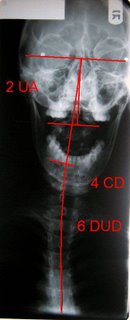
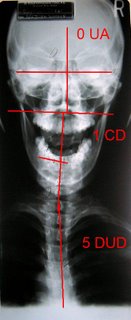
Dolly's pre and post cervical-upper thoracic A-P nasium films taken on 22 Dec 05 & 28 Mar 06


Kristin's Pre & Post cervical-upper thoracic A-P nasium films taken on 24 Mar 06 & 28 Mar 06
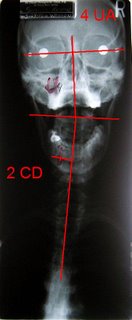
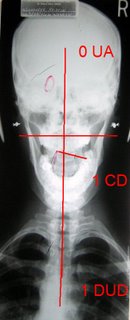
This next series of films looks at the cervical spine and skull from the side, it is called a lateral cervical film. The average human head weighs about 8 lbs. When your head is not directly placed over your shoulders, rather it juts forward, then due to gravity, the amount of weight of your head that your small neck muscles must carry just multiplies. This is called forward head posture. It occurs when the lordotic curve of the neck is lost from ligament damage due to trauma, gravity, or chronic and repetitive poor posture. The film on the left indicates that Kristin's neck was carrying the equivalent of 33 lbs. of weight by supporting her skull. She has severe loss of curve of her neck, 284%. The ideal curve of the neck should be 43 degrees; it should look like a "C" facing toward the back. Instead, she has reverse curvature of her neck beginning to curve the opposite way toward the front of her body. That is very, very BAD!
Kristin's pre & post lateral cervical films taken on 24 Mar 06 & 28 Mar 06

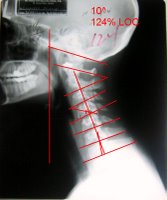
The film on the right indicates a lot of improvement. Kristin's neck is now curving in the correct direction, and she now has 10 degrees of curvature in her cervical spine. She went from 284% loss of curve to 124% loss of curve in just 5 days! In order to maintain rehab and progression of structural correction in the right direction, Kristin & I must both continue with our home care rehab exercises which retrain our muscles and righting reflexes (retraining the brain to accept the ocular and proprioceptive input), otherwise, the fact that our muscles, ligaments, and the nerves that innervate them have been in a different position for so many years, they'll want to revert back to what they're used to. We have to retrain our brains to maintain this structure--so, it's on-going, and it isn't an overnight FIX. Muscles and ligaments take 4-6 weeks to completely rehab and adapt to new positions and training (which is why it takes 4-6 weeks of training in the gym to see results in weightlifting and working out!).
We had a full series of spinal films taken on each of us, but there wasn't enough time in the clinic to take a complete set of post films (our priority was DeJeanne's care, not our own). However, I expect to have my spine and supporting postural muscles, completely rehabilitated to ideals and normals by the time I graduate--mainly because I'm going to work my butt off at rehab, and because I know it is physiologically possible. I can't wait for y'all to see DeJeanne's pre and post films for scoliosis. Expect a post later today!!
We had a full series of spinal films taken on each of us, but there wasn't enough time in the clinic to take a complete set of post films (our priority was DeJeanne's care, not our own). However, I expect to have my spine and supporting postural muscles, completely rehabilitated to ideals and normals by the time I graduate--mainly because I'm going to work my butt off at rehab, and because I know it is physiologically possible. I can't wait for y'all to see DeJeanne's pre and post films for scoliosis. Expect a post later today!!
0 Comments:
Post a Comment
Subscribe to Post Comments [Atom]
<< Home